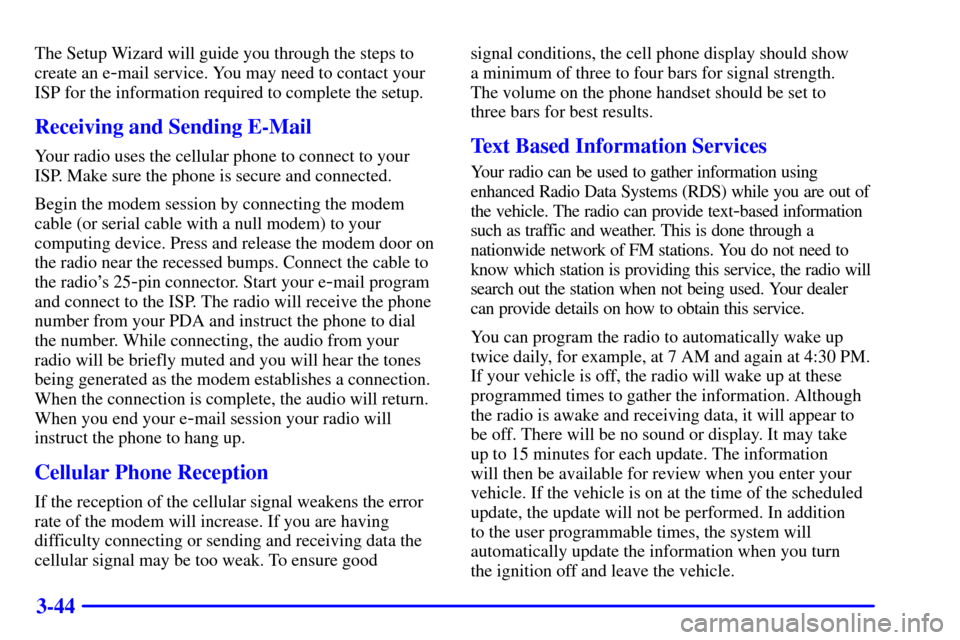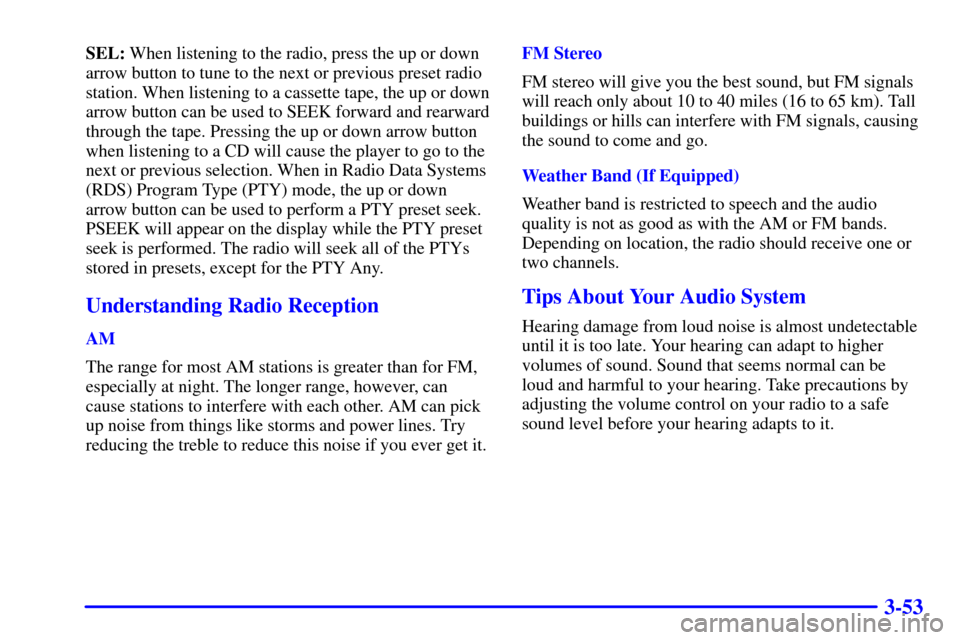Page 198 of 359

3-44
The Setup Wizard will guide you through the steps to
create an e
-mail service. You may need to contact your
ISP for the information required to complete the setup.
Receiving and Sending E-Mail
Your radio uses the cellular phone to connect to your
ISP. Make sure the phone is secure and connected.
Begin the modem session by connecting the modem
cable (or serial cable with a null modem) to your
computing device. Press and release the modem door on
the radio near the recessed bumps. Connect the cable to
the radio's 25
-pin connector. Start your e-mail program
and connect to the ISP. The radio will receive the phone
number from your PDA and instruct the phone to dial
the number. While connecting, the audio from your
radio will be briefly muted and you will hear the tones
being generated as the modem establishes a connection.
When the connection is complete, the audio will return.
When you end your e
-mail session your radio will
instruct the phone to hang up.
Cellular Phone Reception
If the reception of the cellular signal weakens the error
rate of the modem will increase. If you are having
difficulty connecting or sending and receiving data the
cellular signal may be too weak. To ensure good signal conditions, the cell phone display should show
a minimum of three to four bars for signal strength.
The volume on the phone handset should be set to
three bars for best results.
Text Based Information Services
Your radio can be used to gather information using
enhanced Radio Data Systems (RDS) while you are out of
the vehicle. The radio can provide text
-based information
such as traffic and weather. This is done through a
nationwide network of FM stations. You do not need to
know which station is providing this service, the radio will
search out the station when not being used. Your dealer
can provide details on how to obtain this service.
You can program the radio to automatically wake up
twice daily, for example, at 7 AM and again at 4:30 PM.
If your vehicle is off, the radio will wake up at these
programmed times to gather the information. Although
the radio is awake and receiving data, it will appear to
be off. There will be no sound or display. It may take
up to 15 minutes for each update. The information
will then be available for review when you enter your
vehicle. If the vehicle is on at the time of the scheduled
update, the update will not be performed. In addition
to the user programmable times, the system will
automatically update the information when you turn
the ignition off and leave the vehicle.
Page 204 of 359

3-50
PUSHBUTTONS: Press buttons one through six to
select compact discs one through six. These pushbuttons
represent the order of the discs loaded in the changer.
RW: Press and hold this button to reverse quickly
through a track selection.
FF: Press and hold this button to advance quickly
through a track selection.
TUNE
-SEEK: When this button is pressed, it has
two positions. This button works the same, whether
it is pressed to the first or second position. Press this
button to seek to the next or previous selection on the
compact disc.
TRACK SCAN: When you press SCAN for less than
two seconds, you will hear the first few seconds of each
track on a disc. Press SCAN again to stop TRACK
SCAN. The CD will mute while scanning and SCAN
will appear on the display.
DISC SCAN: When you press SCAN for more than
two seconds, you will hear the first few seconds of the
first track on each disc. Press SCAN again to stop
DISC SCAN. The CD will mute while scanning and
SCAN will appear on the display.RDM: Press this button to hear the tracks in random,
rather than sequential, order. RANDOM will appear on
the display. Press TUNE
-SEEK while RDM is on the
display to randomly seek through discs. Press RDM
again to turn off random play.
SIDE: Press this button to select the next disc in
the changer. Each time you press this button, DISC
LOADING will appear on the display and the disc
number on the radio display will go to that of the next
available CD.
SOURCE: Press this button to select a source. The
audio source must be loaded to play. If none of the audio
sources are loaded, NO SOURCE LOADED will appear
on the display. Press this button again or press BAND to
switch back to the radio.
EJECT: Slide the CD changer door all the way
open. Press the upward triangle button. The CD
magazine will eject.
Page 206 of 359
3-52 Theft-Deterrent Feature
THEFTLOCK� is designed to discourage theft of your
radio. Your vehicle has a ªbuilt
-inº theft-deterrent
feature on each radio that is automatic
-- there is
no programming required. The radio in your vehicle
cannot be used in any other vehicle. When the radio
was originally installed in your vehicle at the factory,
it stored the Vehicle Identification Number (VIN).
Each time the ignition is turned on, the VIN is verified.
If the vehicle's VIN does not match the VIN stored in
the radio, THEFTLOCK will be activated and the audio
system will not play. If the radio is removed from your
vehicle, the original VIN in the radio can be used to
trace the radio back to your vehicle.
Audio Steering Wheel Controls
Some audio controls can be adjusted at the steering
wheel. They include the following:
VOL: Press the up arrow button to increase volume and
the down arrow button to decrease volume.
Page 207 of 359

3-53
SEL: When listening to the radio, press the up or down
arrow button to tune to the next or previous preset radio
station. When listening to a cassette tape, the up or down
arrow button can be used to SEEK forward and rearward
through the tape. Pressing the up or down arrow button
when listening to a CD will cause the player to go to the
next or previous selection. When in Radio Data Systems
(RDS) Program Type (PTY) mode, the up or down
arrow button can be used to perform a PTY preset seek.
PSEEK will appear on the display while the PTY preset
seek is performed. The radio will seek all of the PTYs
stored in presets, except for the PTY Any.
Understanding Radio Reception
AM
The range for most AM stations is greater than for FM,
especially at night. The longer range, however, can
cause stations to interfere with each other. AM can pick
up noise from things like storms and power lines. Try
reducing the treble to reduce this noise if you ever get it.FM Stereo
FM stereo will give you the best sound, but FM signals
will reach only about 10 to 40 miles (16 to 65 km). Tall
buildings or hills can interfere with FM signals, causing
the sound to come and go.
Weather Band (If Equipped)
Weather band is restricted to speech and the audio
quality is not as good as with the AM or FM bands.
Depending on location, the radio should receive one or
two channels.
Tips About Your Audio System
Hearing damage from loud noise is almost undetectable
until it is too late. Your hearing can adapt to higher
volumes of sound. Sound that seems normal can be
loud and harmful to your hearing. Take precautions by
adjusting the volume control on your radio to a safe
sound level before your hearing adapts to it.
Page 309 of 359
6-33
To be sure the vent hose (A) is properly attached, the vent
hose connectors (B) must be securely reattached to the vent
outlets (C) on each side of the battery, and the vent assembly
grommet (D) must be secured to the floor pan (E).
Vehicle Storage
If you're not going to drive your vehicle for 25 days
or more, remove the black, negative (
-) cable from
the battery. This will help keep your battery from
running down.
CAUTION:
Batteries have acid that can burn you and gas
that can explode. You can be badly hurt if you
aren't careful. See ªJump Startingº in the Index
for tips on working around a battery without
getting hurt.
Contact your dealer to learn how to prepare your vehicle
for longer storage periods.
Also, for your audio system, see ªTheft
-Deterrent
Featureº in the Index.
Page 342 of 359
6-66
Fuse Usage
6 Heated Seat Left Rear
7 Power Tilt and Telescoping Steering
8 Supplemental Inflation Restraint
9 Not Used
10 Lamps Park Right
11 Fuel Tank Ventilation Solenoid
12 Ignition 1
13 Lamps, Parking Left
14 Interior Lamp Dimmer Module
15 Navigation
16 Heated Seat Left Front
17 Export Lighting
18 Rear Door Modules
19 Stoplamps
20 Neutral Safety Back
-up
21 Audio
22 Retained Accessory Power for SunroofFuse Usage
23 Not Used
24 Not Used
25 Passenger Door Module
26 Fuel Door/Trunk Release (Body)
27 Interior Lamps
28 Rear HVAC Blower
29 Ignition Switch
30 Not Used
31 Heated Seat Right Front
32 Continuous Variable Road
Sensing Suspension
33 Heating, Ventilation, Air Conditioning
34 Ignition 3 Rear
35 Antilock Braking System
36 Turn Signal/Hazard
37 Heated Seat Right Rear
38 Dash Integration Module
Page 343 of 359
6-67
Micro Relays
Relay Usage
39 Fuel Pump
40 Parking Lamps
41 Ignition 1
42 Park Brake A
43 Park Brake B
44 Park Shift Interlock
45 Reverse Lamps
46 Retained Accessory Power for Sunroof
47 Rear HVAC Blower
48 CVRSS Dampers
49 Ignition 3
50 Fuel Tank Door Release
51 Interior Lamps
52 Trunk Release
53 Front Courtesy Lamps
54 Rear Courtesy Lamps
55 Electronic Level Control CompressorCircuit Breakers
Relay Usage
56 Power Seats
57 Power Windows
Mini Relays
Relay Usage
58 Cigarette Lighter
59 Rear Defog
MaxiFuses
Fuse Usage
60 Park Brake
61 Rear Defog
62 Export Brake
63 Audio Amplifier
64 ELC Compressor/Exhaust
65 Cigar Lighter
66 Not Used
The spare fuses are located in numbers 70 through 74.
The fuse puller is located in number 75.
Page:
< prev 1-8 9-16 17-24